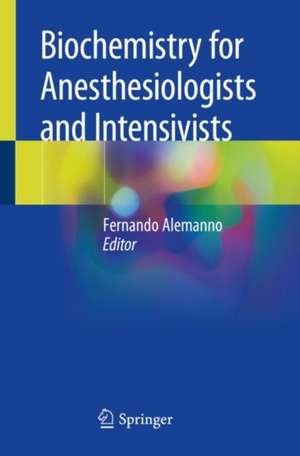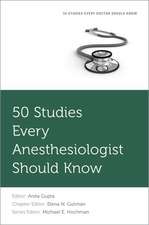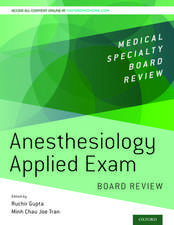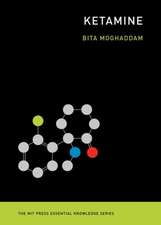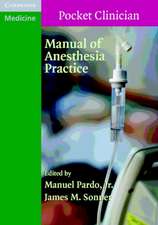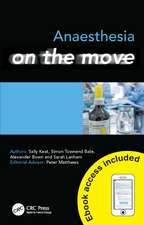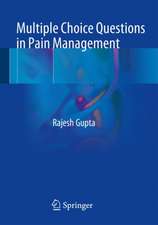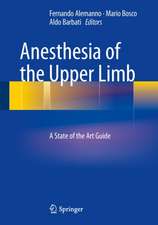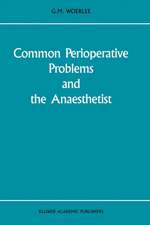Biochemistry for Anesthesiologists and Intensivists
Editat de Fernando Alemannoen Limba Engleză Paperback – 7 noi 2020
The book is intended for anesthesiologists, intensivists, anesthesia teachers, anesthesia trainees and residents.
| Toate formatele și edițiile | Preț | Express |
|---|---|---|
| Paperback (1) | 583.74 lei 38-44 zile | |
| Springer International Publishing – 7 noi 2020 | 583.74 lei 38-44 zile | |
| Hardback (1) | 839.43 lei 38-44 zile | |
| Springer International Publishing – 7 noi 2019 | 839.43 lei 38-44 zile |
Preț: 583.74 lei
Preț vechi: 614.46 lei
-5% Nou
Puncte Express: 876
Preț estimativ în valută:
111.71€ • 116.20$ • 92.23£
111.71€ • 116.20$ • 92.23£
Carte tipărită la comandă
Livrare economică 11-17 aprilie
Preluare comenzi: 021 569.72.76
Specificații
ISBN-13: 9783030267230
ISBN-10: 3030267237
Pagini: 250
Ilustrații: XIV, 250 p. 65 illus., 22 illus. in color.
Dimensiuni: 155 x 235 mm
Ediția:1st ed. 2020
Editura: Springer International Publishing
Colecția Springer
Locul publicării:Cham, Switzerland
ISBN-10: 3030267237
Pagini: 250
Ilustrații: XIV, 250 p. 65 illus., 22 illus. in color.
Dimensiuni: 155 x 235 mm
Ediția:1st ed. 2020
Editura: Springer International Publishing
Colecția Springer
Locul publicării:Cham, Switzerland
Cuprins
Foreword.- Preface.- Chapter 1 Enzymes and Coenzymes.- Chapter 2 Anaerobic Glycolysis or Embden-Meyerhof Pathway.- Chapter 3 The Tricarboxylic Acids Cycle or Krebs Cycle.- Chapter 4 The Collateral Glutamate – GABA Cycle.- Chapter 5 The Pentose Cycle or Direct Oxidative Pathway (DOP) (The Sleep Pathway).- Chapter 6 Neurotransmitters.- Chapter 7 The Blood-Brain Barrier (BBB).- Chapter 8 Shock.- Chapter 9 Cerebral Edema.- Chapter 10 The Pulmonary Surfactant.- Chapter 11 When the Mind Does Not Work As It Should.- Chapter 12 Thiamine (Vitamin B1).- Chapter 13 Normobaric Oxygen Therapy (NBO).- Chapter 14 The Acid – Base equilibrium.- Chapter 15 Theories of Narcosis.- Chapter 16 Local Anaesthetics.- Chapter 17 Perineural Adjuvants.- Chapter 18 The Grand Design.- Chapter 19 Epilogue and Farewell.
Recenzii
“The collection of notes by Dr Alemanno illustrates a deep approach and attitude to learning. … an excellent example of how a diligent deep learner has used biochemistry to justify his long-standing clinical practice. Dr Alemanno is to be applauded for having shared his notes in this book. Only special people do it!” (Getúlio R. de Oliveira Filho, Anesthesia & Analgesia, Vol. 130 (5), May, 2020)
Notă biografică
Professor Alemanno, was Chief of the Department of Anesthesiology Intensive Care and Pain Therapy at the General Hospital of Bolzano. Prior to that he worked at the Department of Anesthesiology and Intensive Care at Padua University and Treviso General Hospital. He still co-operates with the Institute of Anaesthesiology at Verona University and is Consultant at the Institute of Anesthesiology Resuscitation and Pain Therapy Istituti Ospedalieri Bresciani.
He is the originator of a new brachial plexus block technique, published in Regional Anesthesia and Pain Medicine. A speaker at national and international congresses, Prof. Alemanno published 40 papers on anesthesiology, intensive care and pain therapy and is the author of the monograph titled “Anesthesia of the Upper Limb,” published by Springer in 2014.
He is the originator of a new brachial plexus block technique, published in Regional Anesthesia and Pain Medicine. A speaker at national and international congresses, Prof. Alemanno published 40 papers on anesthesiology, intensive care and pain therapy and is the author of the monograph titled “Anesthesia of the Upper Limb,” published by Springer in 2014.
Textul de pe ultima copertă
This book discusses and explains the importance of biochemistry knowledge in understanding what happens to patients during anesthesia and/or to those being in intensive care. It covers a wide range of topics, such as Cerebral Edema, Shock, Blood-Brain Barrier, The Pulmonary surfactant, The Acid – Base equilibrium, Local anaesthetics, Perineural adjuvants, Normobaric Oxygen Therapy, Theories of Narcosis. Hyperventilation effects and consequences are also presented. For instance, by hyperventilating a patient with a PaCO2 significantly below 25 mmHg, we risk blocking pyruvic acid carboxylation and transforming it into oxalacetic acid, which in turn knocks out the Krebs cycle, possibly leading to a complication, i.e. to metabolic acidosis and not to compensation for respiratory alkalosis. It is also worth remembering that vitamins are actually molecules of pretty considerable potency and should not be simply intended as integrators. If we inject a patient under intensive care with vitamin C, this not only plays a capillary-protective role but facilitates the conversion of dopamine to noradrenaline. As far as vitamin B6 goes, not only is it the most natural of antiemetics but the coenzyme responsible for transforming glutamate as one of the most powerful excitatory mediators into GABA, one of the fiercest inhibitors. Anesthesiological and intensive care practice require a detailed biochemistry knowledge to avoid onset of complications and/or to deal with unexpected events promptly and appropriately.
The book is intended for anesthesiologists, intensivists, anesthesia teachers, anesthesia trainees and residents.
Caracteristici
Discusses the role of biochemistry in anesthesia and intensive care Explains how biochemistry is applied in anesthesia and intensive care Covers a wide range of topics
